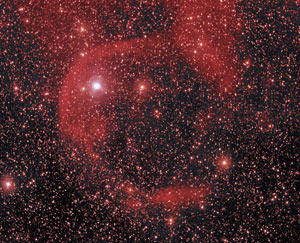NASA’s Wide-field Infrared Survey Explorer took its last image of the sky in February, 2011. But while it was active it surveyed the entire sky several times in the far infrared, so its data archive is a vast treasure trove just waiting to be dug into (hmmm, I should try to squeeze another metaphor into there).
Anyway, lookee what the astronomers found:
Cooool. Literally! That’s dust surrounding the star Alpha Camelopardalis, what appears as a fairly non-descript star in a faint, non-descript constellation. At least, to the eye. When seen in the IR, you get this shocking view. Also literally.
Alpha Cam is a massive, luminous star: 50 times as hefty as our Sun, and blasting out perhaps a million times as much energy. But it’s far away (3000 light years, maybe, the distance is not well-known) and behind a lot of dust, dimming our view. It’s barreling through space at a pretty good clip, and emitting a wind of subatomic particles as it does. This wind expands, slams into the surrounding dust, and sculpting it into this giant bow shock formation. In this false color shot, red is gas and dust warmed to about 130K – that’s -140°C or -200°F! – so warmed is maybe not the best word. But it would be a lot colder if the star’s wind weren’t ramming through it. Green comes from dust at about 240K, or -33°C (-27°F).
 Interestingly, the visible light picture is similar. This shot, from NASA, is sensitive to hydrogen gas. As the wind from the star rams the surrounding material, it carves a bubble on a much larger scale than shown in the WISE image.
Interestingly, the visible light picture is similar. This shot, from NASA, is sensitive to hydrogen gas. As the wind from the star rams the surrounding material, it carves a bubble on a much larger scale than shown in the WISE image.
One day, not too far in the future – a million years, give or take – Alpha Cam will blow, becoming a supernova. It’ll outshine Venus by a fair shot when it does, too. Material ejected in the tremendous explosion will scream outward at a good percentage of the speed of light, and when it hits that junk floating around the star, then we’ll really see a show!
I can wait, though.
Oh, and the title of this post? Camelopardalis is the constellation of the giraffe. So there!
Image Credit: NASA/JPL-Caltech/WISE Team; NASA
Related posts:
- Shocking star is shocking. Shocking, I say!
- The Wonderful
- When a star eats its own